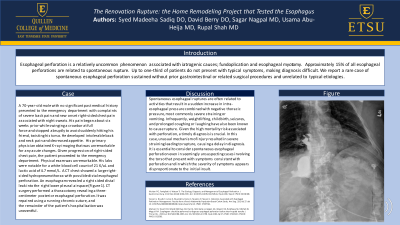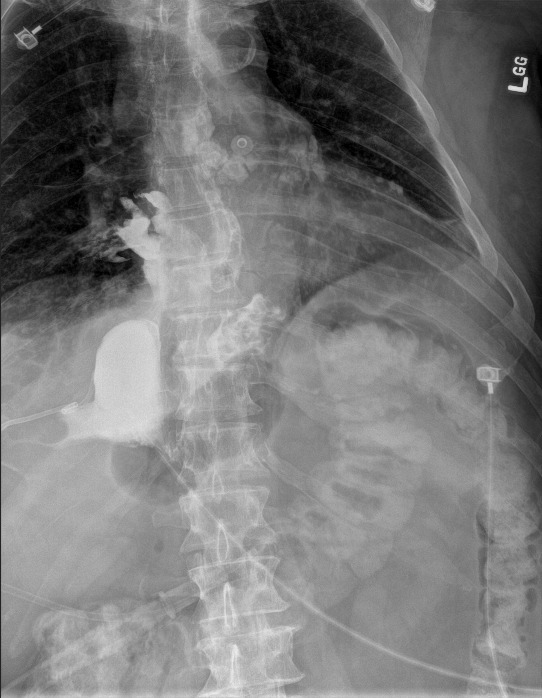Sunday Poster Session
Category: Esophagus
P0481 - The Renovation Rupture: The Home Remodeling Project That Tested the Esophagus
Sunday, October 22, 2023
3:30 PM - 7:00 PM PT
Location: Exhibit Hall

Has Audio
- MS
Madeeha M. Sadiq, DO, MBA
East Tennessee State University
Johnson City, Tennessee
Presenting Author(s)
Syed M. Sadiq, DO, MBA1, David Berry, DO1, Usama Abu-Heija, MD1, Anthony Cecchini, DO1, Raza Hussain, MD2
1East Tennessee State University, Johnson City, TN; 2Team Health, Bristol, TN
Introduction: Esophageal perforation is a relatively uncommon phenomenon associated with iatrogenic causes; fundoplication and esophageal myotomy. Approximately 15% of all esophageal perforations are related to spontaneous rupture. Up to one-third of patients do not present with typical symptoms, making diagnosis difficult. We report a rare case of spontaneous esophageal perforation sustained without prior gastrointestinal or related surgical procedures and unrelated to typical etiologies.
Case Description/Methods: A 70-year-old male with no significant past medical history presented to the emergency department with complaints of severe back pain and new onset right-sided chest pain associated with night sweats. His pain began about six weeks prior while swinging a crowbar at full force and stopped abruptly to avoid suddenly hitting his friend, twisting his torso. He developed intolerable back and neck pain and decreased appetite. His primary physician obtained X-ray imaging that was unremarkable for any acute changes. Given progression of right-sided chest pain, the patient proceeded to the emergency department. Physical exam was unremarkable. His labs were notable for a white blood cell count of 21 K/uL and lactic acid of 4.7 mmol/L. A CT chest showed a large right-sided hydropneumothorax with possible distal esophageal perforation. An esophagram revealed a right sided distal leak into the right lower pleural airspace (Figure 1). CT surgery performed a thoracotomy revealing a three-centimeter posterior esophageal perforation. It was repaired using a running chromic suture, and the remainder of the patient's hospitalization was uneventful.
Discussion: Spontaneous esophageal ruptures are often related to activities that result in a sudden increase in intraesophageal pressure combined with negative thoracic pressure, most commonly severe straining or vomiting. Infrequently, weightlifting, childbirth, seizures, and prolonged coughing or laughing have also been known to cause rupture. Given the high mortality risk associated with perforation, a timely diagnosis is crucial. In this case, unusual mechanism of injury resulted in severe straining leading to rupture, causing a delay in diagnosis. It is essential to consider spontaneous esophageal perforation even in seemingly unsuspecting cases involving the torso that present with symptoms consistent with perforation and in which the severity of symptoms appears disproportionate to the initial insult.

Disclosures:
Syed M. Sadiq, DO, MBA1, David Berry, DO1, Usama Abu-Heija, MD1, Anthony Cecchini, DO1, Raza Hussain, MD2. P0481 - The Renovation Rupture: The Home Remodeling Project That Tested the Esophagus, ACG 2023 Annual Scientific Meeting Abstracts. Vancouver, BC, Canada: American College of Gastroenterology.
1East Tennessee State University, Johnson City, TN; 2Team Health, Bristol, TN
Introduction: Esophageal perforation is a relatively uncommon phenomenon associated with iatrogenic causes; fundoplication and esophageal myotomy. Approximately 15% of all esophageal perforations are related to spontaneous rupture. Up to one-third of patients do not present with typical symptoms, making diagnosis difficult. We report a rare case of spontaneous esophageal perforation sustained without prior gastrointestinal or related surgical procedures and unrelated to typical etiologies.
Case Description/Methods: A 70-year-old male with no significant past medical history presented to the emergency department with complaints of severe back pain and new onset right-sided chest pain associated with night sweats. His pain began about six weeks prior while swinging a crowbar at full force and stopped abruptly to avoid suddenly hitting his friend, twisting his torso. He developed intolerable back and neck pain and decreased appetite. His primary physician obtained X-ray imaging that was unremarkable for any acute changes. Given progression of right-sided chest pain, the patient proceeded to the emergency department. Physical exam was unremarkable. His labs were notable for a white blood cell count of 21 K/uL and lactic acid of 4.7 mmol/L. A CT chest showed a large right-sided hydropneumothorax with possible distal esophageal perforation. An esophagram revealed a right sided distal leak into the right lower pleural airspace (Figure 1). CT surgery performed a thoracotomy revealing a three-centimeter posterior esophageal perforation. It was repaired using a running chromic suture, and the remainder of the patient's hospitalization was uneventful.
Discussion: Spontaneous esophageal ruptures are often related to activities that result in a sudden increase in intraesophageal pressure combined with negative thoracic pressure, most commonly severe straining or vomiting. Infrequently, weightlifting, childbirth, seizures, and prolonged coughing or laughing have also been known to cause rupture. Given the high mortality risk associated with perforation, a timely diagnosis is crucial. In this case, unusual mechanism of injury resulted in severe straining leading to rupture, causing a delay in diagnosis. It is essential to consider spontaneous esophageal perforation even in seemingly unsuspecting cases involving the torso that present with symptoms consistent with perforation and in which the severity of symptoms appears disproportionate to the initial insult.

Figure: Right-sided Distal Esophageal Leak
Disclosures:
Syed Sadiq indicated no relevant financial relationships.
David Berry indicated no relevant financial relationships.
Usama Abu-Heija indicated no relevant financial relationships.
Anthony Cecchini indicated no relevant financial relationships.
Raza Hussain indicated no relevant financial relationships.
Syed M. Sadiq, DO, MBA1, David Berry, DO1, Usama Abu-Heija, MD1, Anthony Cecchini, DO1, Raza Hussain, MD2. P0481 - The Renovation Rupture: The Home Remodeling Project That Tested the Esophagus, ACG 2023 Annual Scientific Meeting Abstracts. Vancouver, BC, Canada: American College of Gastroenterology.
